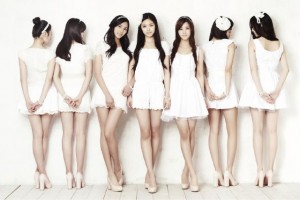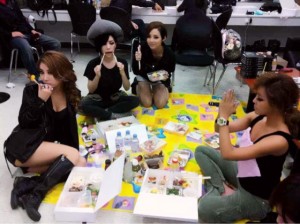 I’m always interested when a non-Korean publication takes a stab at covering some aspect of the Korean entertainment industry, but more often than not, I find myself repeatedly WTFing over what they choose to cover or how they choose to cover it. The Wall Street Journal‘s latest piece on crazy fans who pay exorbitant amounts of money to buy their favorite idols lunch is one such example.
I’m always interested when a non-Korean publication takes a stab at covering some aspect of the Korean entertainment industry, but more often than not, I find myself repeatedly WTFing over what they choose to cover or how they choose to cover it. The Wall Street Journal‘s latest piece on crazy fans who pay exorbitant amounts of money to buy their favorite idols lunch is one such example.
For those of you who don’t feel like reading the article (though I’d encourage you to, as it isn’t long), the short and skinny of it is this: a new food industry has cropped up in Seoul that almost exclusively caters to a fan clientele that has embraced the trend of purchasing lunches for their favorite K-pop stars instead of sending them gaudy or useless trinkets as gifts. This industry responds to the demands of an idol diet (low on calories and high on efficiency) by creating designer dosirak-style lunch boxes (similar to Japanese bento boxes) that fans can order to the tune of anywhere from 70,000-150,000 Korean won per box (~$62-$135). The lunch boxes often come decorated to suit each individual idol’s personality. The lucky recipients of the latest round of these designer dosirak are A Pink. Their health-conscoius meal sounds a lot like half of the menu available at popular Korean bakery chain Paris Baguette. Personally, I find it unappetizing, but I’m also not on some sort of ridiculous diet.
For the record, I don’t necessarily think that gifting idols lunches is a silly idea; I do think that buying gifts for idols in general is a silly idea, but I’ll concede that if you’re going to do it, you might as well invest in something they’ll appreciate. But I still can’t bring myself to believe that there exists sufficient demand to somehow turn this into an apparently lucrative business. The ingredients that went into crafting A Pink’s lunches were really not that exotic or expensive, sans the beef, yet even at its least expensive, the whole package somehow costs upwards of 15 times what I ordinarily paid for lunch when I lived in Seoul. Okay. Who are the insane fans who are willing to shell out this much cash just so that their beloved idols can eat lunch out of a box that prominently features an image of their own face?
 And here’s where the WSJ article takes a decided turn for the creepy: meet A Pink’s generous benefactor, Chung Kyung-young. He is 38 and apparently suffers from the dual problem of having an extreme overabundance of money and no idea what to do with it. He is also, by all appearances, a creeptastic ahjusshi fan who not only paid for all seven members of A Pink to enjoy these extravagant meals, but also for two newspaper advertisements supporting the girls. Mr. Chung explains himself thusly:
And here’s where the WSJ article takes a decided turn for the creepy: meet A Pink’s generous benefactor, Chung Kyung-young. He is 38 and apparently suffers from the dual problem of having an extreme overabundance of money and no idea what to do with it. He is also, by all appearances, a creeptastic ahjusshi fan who not only paid for all seven members of A Pink to enjoy these extravagant meals, but also for two newspaper advertisements supporting the girls. Mr. Chung explains himself thusly:
“Eat rice, cheer up and be strong, that’s the message I am sending them…I am so proud. It feels like giving nice gifts to your beloved nieces.”
The WSJ goes on to mention that he is the father of a nine-year-old boy in what I am sure must be a tongue-in-cheek attempt to draw attention to how utterly strange they find Mr. Chung’s behavior. They do not, however, mention the mother of this nine-year-old boy, and how she might feel about the fact that her husband has dropped a good deal of money on buying presents for a female pop group whose average age is 17.5. Also, I do not buy for one minute that he thinks of these girls as nieces. I don’t know when someone is finally going to delegitimatise this defense as being complete and utter BS designed to cover up the fact that middle-aged men derive a great deal of sexual gratification by watching underage pop stars’ videos and performances, but I suppose that really isn’t what I’m trying to get at here.
As though it weren’t glaringly obvious, I have a few problems with the way the WSJ presented this lunch box phenomenon — mostly because they’ve taken what could potentially be understood as a (hopefully) innocuous and potentially eyebrow-raising fan practice born of an intense desire for fans to give back to idols who have given them so much and turned it into something skin-crawling. Readers who are unfamiliar with Korean pop culture are left with the idea that not only are Korean fans fanatically devoted to the point of spending ridiculous amounts of money on glorified lettuce wraps, but are also perverse men who can somehow publicly admit to being infatuated with minors without being blacklisted or humiliated. I almost can’t believe that the author of the article is, by all appearances, a Korean.
 Of course, this is not to deny that Korean fans are fanatical, or that the ajoshhi fan phenomenon isn’t something about which to be incredibly concerned; both of those things are, I think, objectively true, and both should be adequately treated by both Korean and Western media outlets. However, if you’re going to bring up an ajosshi fan’s inappropriate behavior, then do so within the context of discussing its own inappropriateness. It has no place being mentioned in an article that primarily seeks to draw attention to fan practice in general, and I can think of dozens of other examples to illustrate the fan gift-giving practice (subway advertisements, donations to charities, personalized jewelry) without resorting to an example that will likely raise more questions than it will answer.
Of course, this is not to deny that Korean fans are fanatical, or that the ajoshhi fan phenomenon isn’t something about which to be incredibly concerned; both of those things are, I think, objectively true, and both should be adequately treated by both Korean and Western media outlets. However, if you’re going to bring up an ajosshi fan’s inappropriate behavior, then do so within the context of discussing its own inappropriateness. It has no place being mentioned in an article that primarily seeks to draw attention to fan practice in general, and I can think of dozens of other examples to illustrate the fan gift-giving practice (subway advertisements, donations to charities, personalized jewelry) without resorting to an example that will likely raise more questions than it will answer.
It’s unfortunate, really. I don’t know why, but I feel like the Western media always manages to hit on the strangest or most bizarre aspects of K-pop whenever it makes an appearance in print. This WSJ article would have been odd enough had it just covered the lunch box industry and fan gifts, but at least it would have been an interesting read. Instead, its strangeness is compounded by the off-the-cuff mention of Mr. Chung and his misplaced affection for a bunch of girls who, let’s face it, are essentially jailbait. I just can’t stop headdesking.
All that being said, I suppose if you can get around the incredibly odd placement of Mr. Chung, the article does raise an interesting question for fans: how far are you willing to go to show your devotion to your favorite stars? And so I turn the question over to our Seoulmates: would you buy lunch for your idols? And if you’ve got anything to say about how the WSJ covered this new phenomenon, we’d be glad to hear it!


